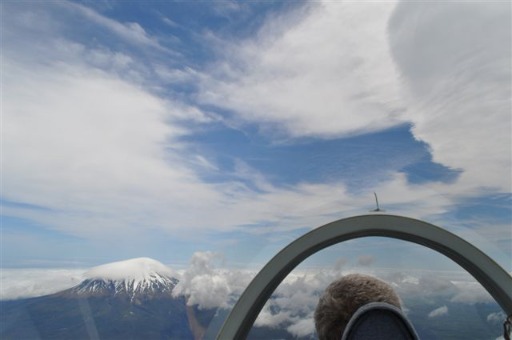Pilots' Stories > John Tullett. November 2010
|
|
John Tullett. November 2010Sunday Wave On Sunday morning I looked at the mountain from my house on Egmont Road and saw that it had a small cap cloud and that there was some straggly looking rotor very close to the slope on what I assumed to be the downwind side. The wind was a strong westerly at Egmont Village and was a gentle easterly from Inglewood to Midhirst. At Stratford there was a Tim and a gusting westerly. Tim suggested a high tow to the southern side of the rotor, John Mcfagden was called and by 12:00 we had prepared and were being towed out to the west. After a fairly rough lower tow, John kindly found some calm air, and we released at 6000’ over between the park boundary and the bush-line. We turned to the right and before you could wonder at the majesty of it all, we were at 9000’ and trying to contact Christchurch control for permission to 15000’. After 10 minutes of not going above 9,500’ we got clearance via New Plymouth and were at 15,000 with the brakes out within 5 minutes. We then had a very enjoyable hour and a half cruising in and around smooth and powerful lift. We tried to find a pressure wave to the west but didn’t contact it. We went downwind a little to see if there was secondary wave, but didn’t find any of that either. A wander in wave along the Pouakais and back to Fanthams Peak. Lift of more than 1000' a minute caused us to wonder how high the system went. Above us, we saw part of the answer in a well formed lennie at around 25,000'. Tim was keen to explore it but I chickened out, or was it the other way round, or perhaps it was both of us who wanted to explore it and we both chickened out. As you can see from the photos, there appeared to be turbulence in the lee of the mountain and a clear area to the extremities of the mountain wake. I made the assumption that these areas would be calm or at least stable. Tim reckoned they would be rough. I should have known he would be right. Throughout the flight ,Tim had been reading out ground speeds. Into wind we had been doing 30 knots and down wind, around 70. Work it out for yourselves. On our final run towards Stratford, our airspeed was 50 knots and our groundspeed was 80. This seemed to indicate that the wind had picked up a bit since our take off. Around 3000’ the rough air started. I casually asked Tim if he would like to land the glider, hoping he would take over. He is not a sensitive person, as he didn’t pick up the note of hopeful desperation I was trying to convey. I was stuck with it. Down wind was very fast and rough. Cross-wind was sideways and very rough. Final was slow and very rough. Tim stayed in the glider to hold it down while the car came to tow us. Two records set: • It was very hot and I took off my trousers at 13,000’ • Christchurch control radioed us at one point and told us not to descend below 10,000’ until advised. This was a stunning flight in all aspects. It revealed conditions we have often seen from the airfield but have previously not taken advantage of. It reinforced the value of flying with an experienced pilot. It was a safe but pointed lesson in the continuum of conditions from benign to extreme that can exist in the same piece of sky at the same time. Above all, it was a wondrous privilege to be in the sky on Sunday. John Tullett  Cap cloud, Rotor and high above (right) the lenticular cloud. |
